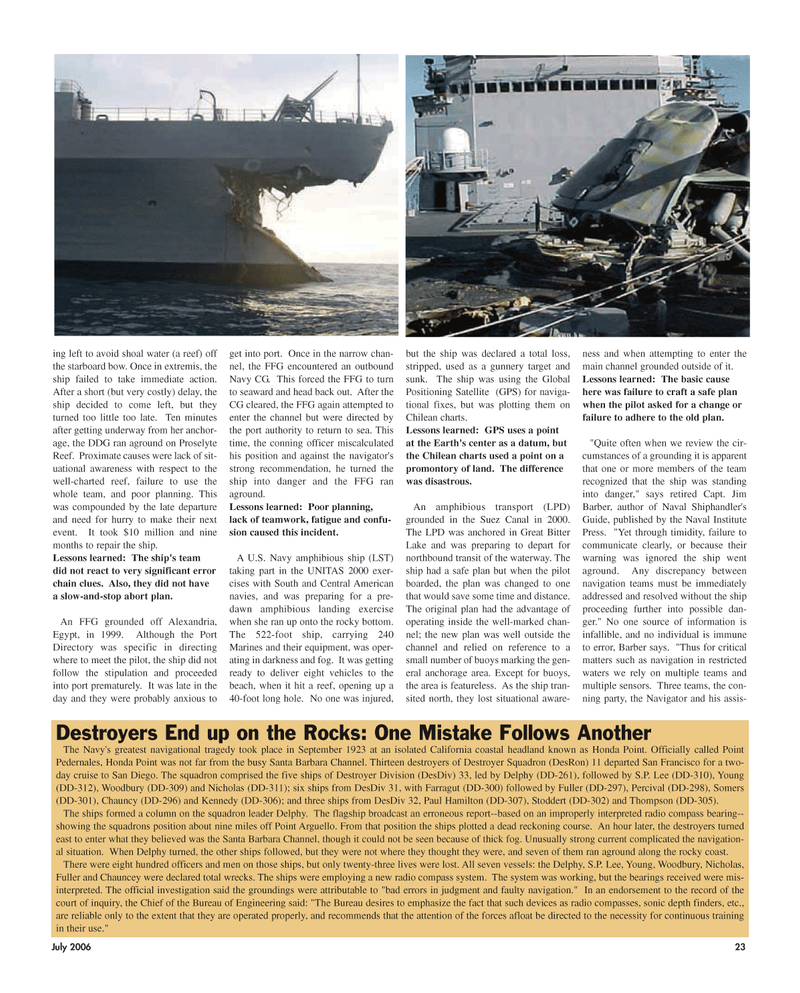
Page 23: of Maritime Reporter Magazine (July 2005)
The Satellite Communications Edition
Read this page in Pdf, Flash or Html5 edition of July 2005 Maritime Reporter Magazine
ing left to avoid shoal water (a reef) off the starboard bow. Once in extremis, the ship failed to take immediate action.
After a short (but very costly) delay, the ship decided to come left, but they turned too little too late. Ten minutes after getting underway from her anchor- age, the DDG ran aground on Proselyte
Reef. Proximate causes were lack of sit- uational awareness with respect to the well-charted reef, failure to use the whole team, and poor planning. This was compounded by the late departure and need for hurry to make their next event. It took $10 million and nine months to repair the ship.
Lessons learned: The ship's team did not react to very significant error chain clues. Also, they did not have a slow-and-stop abort plan.
An FFG grounded off Alexandria,
Egypt, in 1999. Although the Port
Directory was specific in directing where to meet the pilot, the ship did not follow the stipulation and proceeded into port prematurely. It was late in the day and they were probably anxious to get into port. Once in the narrow chan- nel, the FFG encountered an outbound
Navy CG. This forced the FFG to turn to seaward and head back out. After the
CG cleared, the FFG again attempted to enter the channel but were directed by the port authority to return to sea. This time, the conning officer miscalculated his position and against the navigator's strong recommendation, he turned the ship into danger and the FFG ran aground.
Lessons learned: Poor planning, lack of teamwork, fatigue and confu- sion caused this incident.
A U.S. Navy amphibious ship (LST) taking part in the UNITAS 2000 exer- cises with South and Central American navies, and was preparing for a pre- dawn amphibious landing exercise when she ran up onto the rocky bottom.
The 522-foot ship, carrying 240
Marines and their equipment, was oper- ating in darkness and fog. It was getting ready to deliver eight vehicles to the beach, when it hit a reef, opening up a 40-foot long hole. No one was injured, but the ship was declared a total loss, stripped, used as a gunnery target and sunk. The ship was using the Global
Positioning Satellite (GPS) for naviga- tional fixes, but was plotting them on
Chilean charts.
Lessons learned: GPS uses a point at the Earth's center as a datum, but the Chilean charts used a point on a promontory of land. The difference was disastrous.
An amphibious transport (LPD) grounded in the Suez Canal in 2000.
The LPD was anchored in Great Bitter
Lake and was preparing to depart for northbound transit of the waterway. The ship had a safe plan but when the pilot boarded, the plan was changed to one that would save some time and distance.
The original plan had the advantage of operating inside the well-marked chan- nel; the new plan was well outside the channel and relied on reference to a small number of buoys marking the gen- eral anchorage area. Except for buoys, the area is featureless. As the ship tran- sited north, they lost situational aware- ness and when attempting to enter the main channel grounded outside of it.
Lessons learned: The basic cause here was failure to craft a safe plan when the pilot asked for a change or failure to adhere to the old plan. "Quite often when we review the cir- cumstances of a grounding it is apparent that one or more members of the team recognized that the ship was standing into danger," says retired Capt. Jim
Barber, author of Naval Shiphandler's
Guide, published by the Naval Institute
Press. "Yet through timidity, failure to communicate clearly, or because their warning was ignored the ship went aground. Any discrepancy between navigation teams must be immediately addressed and resolved without the ship proceeding further into possible dan- ger." No one source of information is infallible, and no individual is immune to error, Barber says. "Thus for critical matters such as navigation in restricted waters we rely on multiple teams and multiple sensors. Three teams, the con- ning party, the Navigator and his assis-
Destroyers End up on the Rocks: One Mistake Follows Another
The Navy's greatest navigational tragedy took place in September 1923 at an isolated California coastal headland known as Honda Point. Officially called Point
Pedernales, Honda Point was not far from the busy Santa Barbara Channel. Thirteen destroyers of Destroyer Squadron (DesRon) 11 departed San Francisco for a two- day cruise to San Diego. The squadron comprised the five ships of Destroyer Division (DesDiv) 33, led by Delphy (DD-261), followed by S.P. Lee (DD-310), Young (DD-312), Woodbury (DD-309) and Nicholas (DD-311); six ships from DesDiv 31, with Farragut (DD-300) followed by Fuller (DD-297), Percival (DD-298), Somers (DD-301), Chauncy (DD-296) and Kennedy (DD-306); and three ships from DesDiv 32, Paul Hamilton (DD-307), Stoddert (DD-302) and Thompson (DD-305).
The ships formed a column on the squadron leader Delphy. The flagship broadcast an erroneous report--based on an improperly interpreted radio compass bearing-- showing the squadrons position about nine miles off Point Arguello. From that position the ships plotted a dead reckoning course. An hour later, the destroyers turned east to enter what they believed was the Santa Barbara Channel, though it could not be seen because of thick fog. Unusually strong current complicated the navigation- al situation. When Delphy turned, the other ships followed, but they were not where they thought they were, and seven of them ran aground along the rocky coast.
There were eight hundred officers and men on those ships, but only twenty-three lives were lost. All seven vessels: the Delphy, S.P. Lee, Young, Woodbury, Nicholas,
Fuller and Chauncey were declared total wrecks. The ships were employing a new radio compass system. The system was working, but the bearings received were mis- interpreted. The official investigation said the groundings were attributable to "bad errors in judgment and faulty navigation." In an endorsement to the record of the court of inquiry, the Chief of the Bureau of Engineering said: "The Bureau desires to emphasize the fact that such devices as radio compasses, sonic depth finders, etc., are reliable only to the extent that they are operated properly, and recommends that the attention of the forces afloat be directed to the necessity for continuous training in their use."
July 2006 23
MR JULY2006 #3 (17-24).qxd 7/5/2006 11:42 AM Page 23

 22
22

 24
24
